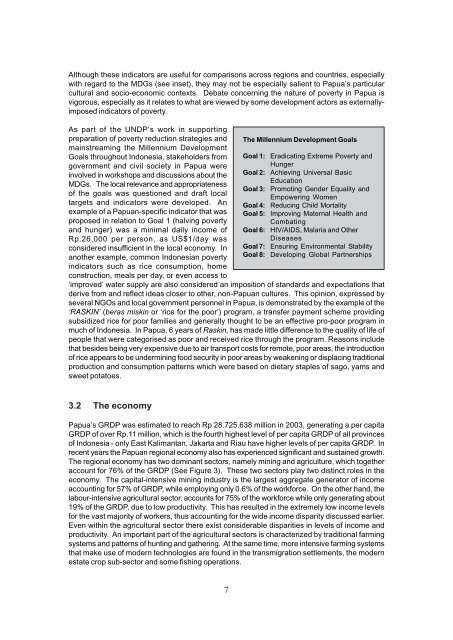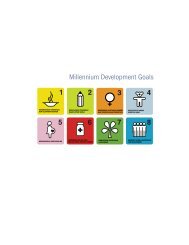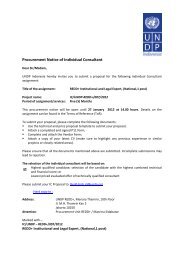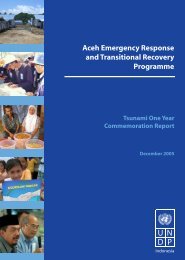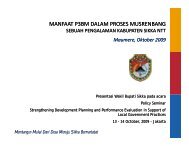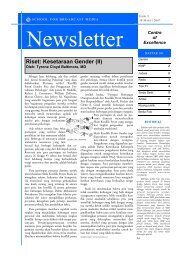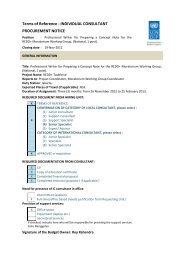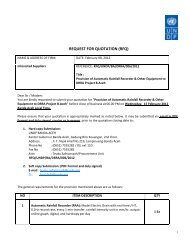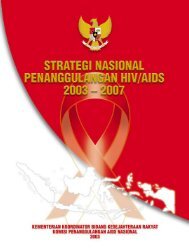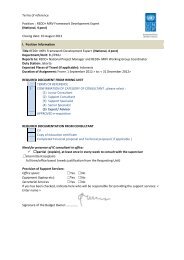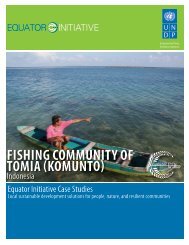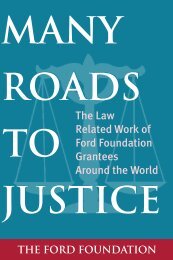Papua Needs Assessment - UNDP
Papua Needs Assessment - UNDP
Papua Needs Assessment - UNDP
Create successful ePaper yourself
Turn your PDF publications into a flip-book with our unique Google optimized e-Paper software.
Although these indicators are useful for comparisons across regions and countries, especially<br />
with regard to the MDGs (see inset), they may not be especially salient to <strong>Papua</strong>’s particular<br />
cultural and socio-economic contexts. Debate concerning the nature of poverty in <strong>Papua</strong> is<br />
vigorous, especially as it relates to what are viewed by some development actors as externallyimposed<br />
indicators of poverty.<br />
As part of the <strong>UNDP</strong>’s work in supporting<br />
preparation of poverty reduction strategies and<br />
mainstreaming the Millennium Development<br />
Goals throughout Indonesia, stakeholders from<br />
government and civil society in <strong>Papua</strong> were<br />
involved in workshops and discussions about the<br />
MDGs. The local relevance and appropriateness<br />
of the goals was questioned and draft local<br />
targets and indicators were developed. An<br />
example of a <strong>Papua</strong>n-specific indicator that was<br />
proposed in relation to Goal 1 (halving poverty<br />
and hunger) was a minimal daily income of<br />
Rp.26,000 per person, as US$1/day was<br />
considered insufficient in the local economy. In<br />
another example, common Indonesian poverty<br />
indicators such as rice consumption, home<br />
construction, meals per day, or even access to<br />
The Millennium Development Goals<br />
Goal 1: Eradicating Extreme Poverty and<br />
Hunger<br />
Goal 2: Achieving Universal Basic<br />
Education<br />
Goal 3: Promoting Gender Equality and<br />
Empowering Women<br />
Goal 4: Reducing Child Mortality<br />
Goal 5: Improving Maternal Health and<br />
Combating<br />
Goal 6: HIV/AIDS, Malaria and Other<br />
Diseases<br />
Goal 7: Ensuring Environmental Stability<br />
Goal 8: Developing Global Partnerships<br />
‘improved’ water supply are also considered an imposition of standards and expectations that<br />
derive from and reflect ideas closer to other, non-<strong>Papua</strong>n cultures. This opinion, expressed by<br />
several NGOs and local government personnel in <strong>Papua</strong>, is demonstrated by the example of the<br />
‘RASKIN’ (beras miskin or ‘rice for the poor’) program, a transfer payment scheme providing<br />
subsidized rice for poor families and generally thought to be an effective pro-poor program in<br />
much of Indonesia. In <strong>Papua</strong>, 6 years of Raskin, has made little difference to the quality of life of<br />
people that were categorised as poor and received rice through the program. Reasons include<br />
that besides being very expensive due to air transport costs for remote, poor areas, the introduction<br />
of rice appears to be undermining food security in poor areas by weakening or displacing traditional<br />
production and consumption patterns which were based on dietary staples of sago, yams and<br />
sweet potatoes.<br />
3.2 The economy<br />
<strong>Papua</strong>’s GRDP was estimated to reach Rp 28.725.638 million in 2003, generating a per capita<br />
GRDP of over Rp.11 million, which is the fourth highest level of per capita GRDP of all provinces<br />
of Indonesia - only East Kalimantan, Jakarta and Riau have higher levels of per capita GRDP. In<br />
recent years the <strong>Papua</strong>n regional economy also has experienced significant and sustained growth.<br />
The regional economy has two dominant sectors, namely mining and agriculture, which together<br />
account for 76% of the GRDP (See Figure 3). These two sectors play two distinct roles in the<br />
economy. The capital-intensive mining industry is the largest aggregate generator of income<br />
accounting for 57% of GRDP, while employing only 0.6% of the workforce. On the other hand, the<br />
labour-intensive agricultural sector, accounts for 75% of the workforce while only generating about<br />
19% of the GRDP, due to low productivity. This has resulted in the extremely low income levels<br />
for the vast majority of workers, thus accounting for the wide income disparity discussed earlier.<br />
Even within the agricultural sector there exist considerable disparities in levels of income and<br />
productivity. An important part of the agricultural sectors is characterized by traditional farming<br />
systems and patterns of hunting and gathering. At the same time, more intensive farming systems<br />
that make use of modern technologies are found in the transmigration settlements, the modern<br />
estate crop sub-sector and some fishing operations.<br />
7


